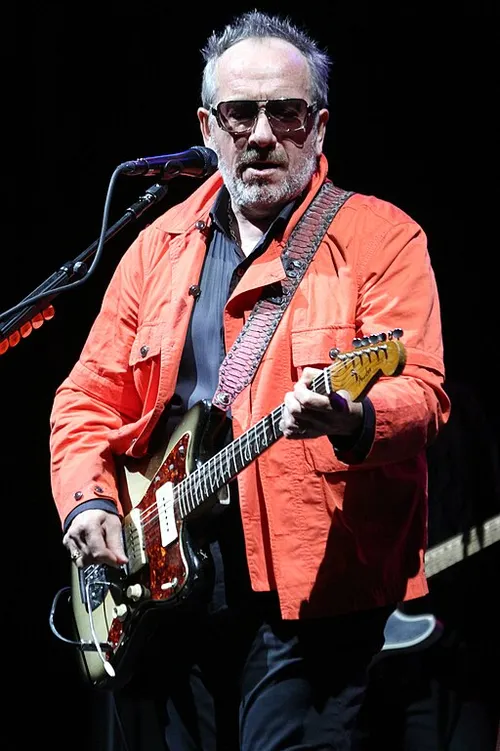Summary
Costello’s music has evolved over the years, incorporating diverse influences such as country (Almost Blue), jazz, and classical. His collaborations with artists like Paul McCartney, Burt Bacharach, and The Roots have added new dimensions to his sound. This evolution has kept his music fresh and intriguing, and it’s no wonder he was inducted into both the Rock and Roll Hall of Fame and the Songwriters Hall of Fame.
Born: Declan Patrick MacManus on 25 August 1954, in London, England
Stage Name Origin: A blend of Elvis Presley and his father’s stage name, Day Costello
Genres: Rock, punk, new wave, pop, country, jazz, classical
Career Span: 1970–present
🎶 “She” by Elvis Costello: Background and Meaning
Original Composer: Charles Aznavour
English Lyrics: Herbert Kretzmer
Costello’s Version: Recorded for the 1999 film Notting Hill
https://www.youtube.com/watch?v=JsYj0EkZyYw
https://www.youtube.com/watch?v=fh0F-2kfSZA
https://www.youtube.com/watch?v=-XklKTUtfm4
Elvis Costello’s rendition of “She” is a cover of Aznavour’s original French song Tous Les Visages De L’Amour. His version gained widespread recognition through its use in Notting Hill, where it underscored the film’s romantic themes.
🌹 Themes and Interpretation
“She” explores the complexity of love and the enigmatic nature of the beloved. The lyrics describe a woman who is:
- Both joyful and sorrowful, public and private
- Capable of bringing pleasure or regret, heaven or hell
- The reason for the narrator’s existence, despite her contradictions
The emotional depth of “She” lies in its portrayal of unconditional devotion. The narrator’s acceptance of both the beauty and the pain of loving deeply resonates with the listener, creating a sense of connection and empathy.
💫 Why It Resonates
Costello’s delivery—paired with a lush orchestral arrangement—adds melancholy and grandeur, making it a timeless ballad about romantic idealism, vulnerability, and emotional risk.
Elvis Costello’s rendition of “She” is a masterclass in romantic balladry, with a lush orchestral arrangement that elevates the emotional weight of the lyrics. Here’s a breakdown of the musical structure and instrumentation:
🎼 Musical Arrangement Breakdown of “She” (Elvis Costello version)
1. Key and Tempo
- Key: D♭ Major
- Tempo: ~75 BPM (slow ballad pace)
- The key choice adds warmth and emotional depth, ideal for a romantic theme.
2. Instrumentation
The arrangement is orchestral and cinematic, reflecting its use in Notting Hill:
- Piano:
- Provides the harmonic foundation and rhythmic pulse.
- Plays arpeggiated chords and gentle fills to support the vocal line.
- Strings (Violin, Viola, Cello, Contrabass):
- Create a sweeping, emotive backdrop.
- Use legato phrasing and dynamic swells to mirror the song’s emotional arc.
- Often double the vocal melody subtly for reinforcement.
- Brass (French Horn, Trumpet, Tuba):
- Used sparingly for dramatic emphasis, especially in the chorus.
- Adds a regal, cinematic quality.
- Woodwinds (Flute, Clarinet, Oboe):
- Provide soft counter-melodies and harmonic texture.
- Enhance the romantic and introspective mood.
- Percussion:
- Minimal, often limited to timpani rolls or cymbal swells for transitions.
- No drum kit—maintains the classical ballad feel.
3. Vocal Arrangement
- Elvis Costello’s vocal delivery is restrained yet expressive.
- He uses subtle vibrato and dynamic control to convey vulnerability.
- The phrasing is conversational, allowing the lyrics to shine.
4. Structure
- Intro: Solo piano sets the tone
- Verse 1 & 2: Gradual layering of strings and woodwinds
- Chorus: Full orchestral swell, emotional peak
- Bridge: Slight modulation and harmonic tension
- Final Chorus: Climactic orchestration, then tapering to a soft outro
Here’s a comparative breakdown of the musical arrangements of “She” by Charles Aznavour (1974 original) and Elvis Costello (1999 cover):
🎼 Charles Aznavour’s Original Version (1974)
https://www.youtube.com/watch?v=ajjdY070VU4
https://en.wikipedia.org/wiki/She_(Charles_Aznavour_song)
Style & Mood
- Genre: Pop ballad with chanson influences
- Mood: Romantic, nostalgic, slightly theatrical
- Length: ~2:50 minutes
Instrumentation
- Orchestration:
- Strings: Light string section, used more sparingly than Costello’s version
- Piano: Prominent, but more rhythmic and less lush
- Woodwinds & Brass: Used subtly for color, not cinematic
- Drums/Bass: Present, giving it a gentle pop groove
Vocal Delivery
- Aznavour’s voice is intimate and expressive, with a slight vibrato and French chanson phrasing.
- His delivery is more narrative and conversational, emphasizing the lyrics’ poetic nature.
Structure
- Verse-Chorus format, but with a more fluid transition between sections.
- The arrangement builds modestly, never reaching the orchestral swell of Costello’s version.
🎶 Elvis Costello’s Version (1999)
Style & Mood
- Genre: Orchestral pop ballad
- Mood: Cinematic, melancholic, grand
- Length: ~3:10 minutes
Instrumentation
- Full orchestral arrangement:
- Strings: Sweeping and dominant, creating emotional swells
- Piano: Rich and resonant, often playing arpeggios
- Brass & Woodwinds: Used for dramatic emphasis
- Percussion: Minimal, mostly cymbal rolls and timpani for transitions
Vocal Delivery
- Costello’s voice is restrained and emotive, with a subtle vulnerability.
- His phrasing is more legato, allowing the orchestration to breathe around the vocals.
Structure
- More cinematically structured, with a clear build-up to a climactic final chorus.
- Designed to underscore a film’s emotional arc, especially in Notting Hill.
🎵 Key Differences
|
Element |
Aznavour (1974) |
Costello (1999) |
|
Mood |
Intimate, poetic |
Cinematic, dramatic |
|
Instrumentation |
Light pop with chanson touches |
Full orchestral backing |
|
Vocal Style |
Narrative, expressive |
Restrained, melancholic |
|
Purpose |
Standalone single |
Film soundtrack centerpiece |
|
Emotional Arc |
Gentle and reflective |
Sweeping and emotionally climactic |
